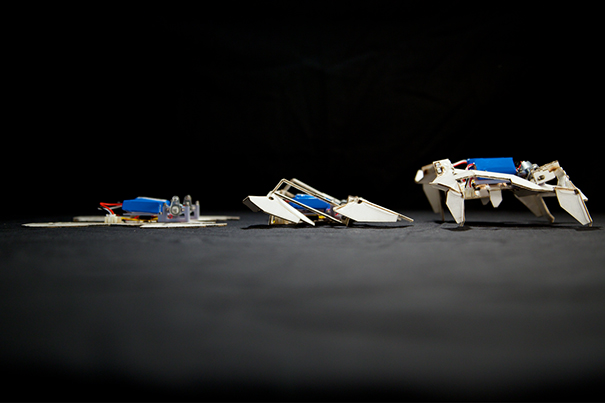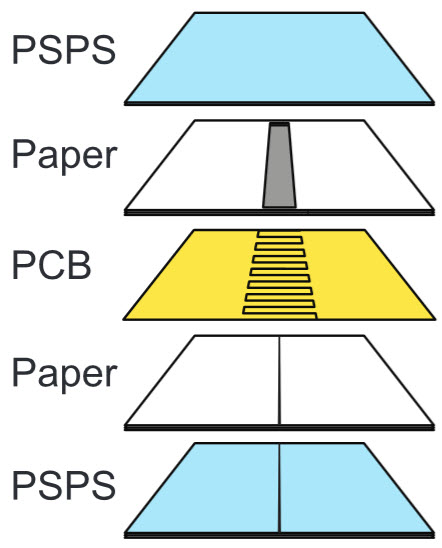Robot folds itself up, walks away
August 10, 2014

The self-assembled paper robots arise (credit: Seth Kroll)
Engineers at Harvard School of Engineering and Applied Sciences (SEAS), Wyss Institute, and MIT have developed a robot that assembles itself into a complex shape in four minutes flat, then folds itself up and crawls away — all without human intervention.
The design was based on the principle of Shrinky Dinks (the classic children’s toy that shrinks a plastic-paper composite in a rigid form when heated).

The robot self-assembles in five steps, aided by two motors (start and finish steps shown). Once the final folds cool, the robot is ready for operation. (Credit: S. Felton et al./Science)

The robot’s self-folding shape-memory composite material consists of five layers: two outer layers of a shape-memory polymer (PSPS) mechanically programmed to contract bidirectionally when heated to approximately 100°C, two layers of paper, and a layer of polyimide (PCB) bearing a copper circuit in the middle (credit: S. Felton et al./Science)
The technique can be used to “rapidly prototype electromechanical systems, build satellites that assemble themselves in space, and fabricate centimeter-scale robots,” the researches say in the journal Science.
“Imagine a ream of dozens of robotic satellites sandwiched together so that they could be sent up to space and then assemble themselves remotely once they get there,” said lead author Sam Felton, a doctoral student at SEAS. :They could take images, collect data, and more.”
The sophisticated machines can interact with the environment and automate much of the design and assembly process, the engineers say.
The method draws inspiration from self-assembly in nature, such as the way linear sequences of amino acids fold into complex proteins with sophisticated functions.
“Getting a robot to assemble itself autonomously and actually perform a function has been a milestone we’ve been chasing for many years,” said senior author Robert J. Wood, Charles River Professor of Engineering and Applied Sciences at the Harvard School of Engineering and Applied Sciences (SEAS) and a core faculty member at the Wyss Institute for Biologically Inspired Engineering at Harvard.
The robots are the culmination of a series of advances made by the team over the last few years, including development of a printed robotic inchworm — which still required human involvement while folding itself — and a self-folding lamp that had to be turned on by a person after it assembled itself.
Harvard University | A team of engineers at Harvard and MIT have designed and built a flat-packed robot that assembles itself and walks away.
Origami-inspired
The new robot is the first that builds itself and also performs a function, all without human intervention.
“Here we created a full electromechanical system that was embedded into one flat sheet,” Felton said. The team used computer-design tools to inform the optimal design and fold pattern. After about 40 prototypes, Felton honed in on one that could fold itself up and walk away. He fabricated the sheet using a solid ink printer, a laser machine, and his hands.
The refined design took only about two hours to assemble using a method that relies on the power of origami, the ancient Japanese art whereby a single sheet of paper can be folded into complex structures. The origami-inspired approach enabled the team to avoid the traditional “nuts and bolts” approach to assembling complex machines.
The team started with a flat sheet, to which it added two motors, two batteries, and a microcontroller, which acts like the robot’s brain. The sheet was a composite of paper and Shrinky Dinks, also called polystyrene, and a flexible circuit board in the middle. It also included hinges that were programmed to fold at specific angles. Each hinge contained embedded circuits that produce heat on command from the microcontroller. The heat triggers the composite to fold itself in a series of steps.
When the hinges cool after about four minutes, the polystyrene hardens, making the robot stiff, and the microcontroller then signals the robot to crawl away at a speed of about one-tenth of a mile per hour. The entire event consumed roughly the amount of energy in one AA alkaline battery.
The robot operates on a timer, waiting about 10 seconds after the batteries are installed to begin folding. However, “We could easily modify this such that the folding is triggered by an environmental sensor, such as temperature or pressure,” Felton said.
The self-folding method is complementary to 3D printing, which struggles to integrate the electrical components and, in this case, it would have taken a lot longer to produce the functional prototype.
A community shared-robot facility
The long-term dream of this work, Wood said, is to have a facility that everyone could access around the clock in their community when they might have a need for robotic assistance, from everyday house and porch sweeping to detecting gas leaks in the neighborhood.
“You would be able to come in, describe what you need in fairly basic terms, and come back an hour later to get your robotic helper,” Wood said. All told, each robot cost about $100, but only $20 for the body without the motors, batteries, and microcontroller.
“This achievement by Rob and his team changes the way we think about manufacturing, in that the machine fabricates itself,” said Don Ingber, founding director of the Wyss Institute, Judah Folkman Professor of Vascular Biology at Harvard Medical School, and professor of bioengineering at Harvard SEAS. “The days of big, rigid, robots that sit in place and carry out the same repetitive task day in and out are fading fast.”
This work was funded by the National Science Foundation, the Wyss Institute for Biologically Inspired Engineering at Harvard University, and the Air Force Office of Scientific Research through a National Defense Science and Engineering Graduate Fellowship.
Abstract of Science paper
Origami can turn a sheet of paper into complex three-dimensional shapes, and similar folding techniques can produce structures and mechanisms. To demonstrate the application of these techniques to the fabrication of machines, we developed a crawling robot that folds itself. The robot starts as a flat sheet with embedded electronics, and transforms autonomously into a functional machine. To accomplish this, we developed shape-memory composites that fold themselves along embedded hinges. We used these composites to recreate fundamental folded patterns, derived from computational origami, that can be extrapolated to a wide range of geometries and mechanisms. This origami-inspired robot can fold itself in 4 minutes and walk away without human intervention, demonstrating the potential both for complex self-folding machines and autonomous, self-controlled assembly.